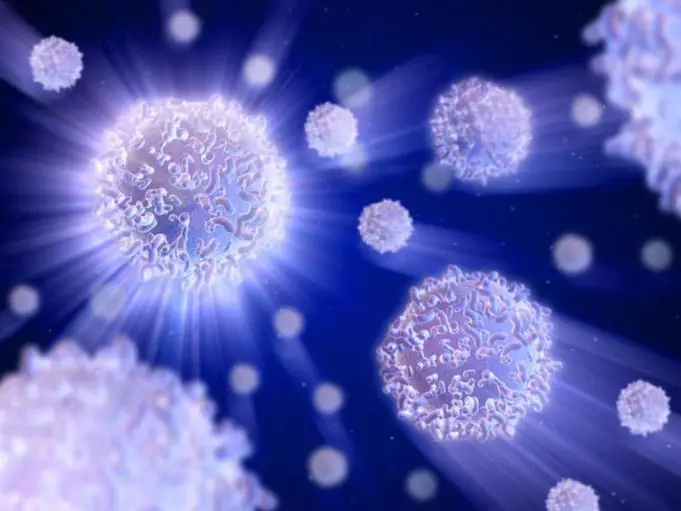White blood cells, also known as leukocytes, are the cells that make up the immune system that protects the body from infections and microbial alien invaders.
The white blood cells are produced from cells present in the bone marrow known as hematopoietic stem cells. White blood cells are found throughout the body.
Leukocytes are components of the blood that lack hemoglobin. They are distinguished from other cells in the blood due to the presence of nuclei. They are capable of movement and destroy infections and cancers by producing antibodies, or by ingesting them.
A healthy adult human has about 4,000 to 11,000 white blood cells per microliter of blood, making white blood cells approximately 1 percent of the total blood volume in a healthy adult. White blood cells are lesser in number than red blood cells.
Changes in the number of white blood cells occur during the day; higher values happen during exercise, while lower values occur when the body is at rest. An increase in the number of white blood cells past the upper limits is known as leukocytosis.
This could arise as a result of the body’s response to infection or foreign bodies, convulsions, exercise, emotional reactions, labor, pregnancy, or pain. A low number of white blood cells is known as leukopenia.
This disorder may occur in response to certain conditions such as anaphylaxis, malnutrition, and anemia. It could also occur as a result of certain types of medication and infection.
White blood cells are present within and outside the bloodstream, where they are circulated. In the bloodstream, they are in transit from one place to another. While the ones present in tissues help fight off infections.
The survival of white blood cells depends on the continuous production of energy. The chemical pathways consist of a system more complicated than that of red blood cells and are similar to those of other tissue cells.
They contain ribonucleic acid (RNA), a nucleus, and they are capable of synthesizing protein. White blood cells do not undergo mitosis (cell division), although some are capable of dividing, and they are highly differentiated to perform specific functions.
White blood cells are classified based on their appearance under a light microscope. These classifications are;
Lymphocytes
These are white blood cells that are further divided into the B cells and the T cells.
They are responsible for identifying alien agents in the body and the subsequent removal of the agents from the host. B cells secrete antibodies – proteins that bind to foreign microbes in the tissues of the body – and further destroy them.
Usually, T cells identify cells infected by cancer or virus and destroy them. They also assist in the production of antibodies by the B cells. Included in this group are the natural killer cells (NK cells), named for their ability to eliminate a wide range of target cells.
There is about 25 to 33 percent of white blood cells in a healthy individual.
Granulocytes
These are the most types of white blood cells. They remove large pathogenic organisms like helminths and protozoans from the host body.
They are also vital mediators of allergies and other forms of inflammation. Granulocytes contain many cytoplasmic granules that contain chemicals that are important to the immune system.
Their nuclei are multi-lobed, and it is for this reason that they are usually called polymorphonuclear cells.
Granulocytes are further categorized base on how they take up dye in the laboratory. These categories are:
- Neutrophils make up most of the white blood cells. They are the first at the site of infection where there engulf and eliminate the infectious microbe in a process known as phagocytosis.
- Eosinophils which destroy parasite and help modulate inflammatory responses
- Basophils contain chemicals such as leukotrienes and histamine that are important in inducing allergic reactions.
Monocytes
These constitute about 4 to 8 percent of the total number of leukocytes in the blood. They move for the blood to the point of infection where they differentiate further into macrophages.
These cells are scavengers, and they engulf and consume whole microorganisms or those that have been killed, making them very useful at the direct elimination of pathogens and clean up cellular debris from the point of infection.
Although neutrophils and macrophages are the primary phagocytic cells in the body, macrophages live longer and are much larger than neutrophils. Some macrophages play an essential role as antigen-presenting cells.
They phagocytose and degrade microorganisms and present parts of these microbes to the T cells, hence, activating the immune response.
Specific types of white blood cells are linked to different diseases, and these reflect the unique function of that particular cell in the body’s defense. Generally, infants have a high white blood cell count, and this number falls gradually with age.
High White Blood Cell Count
An elevated amount of white blood cells in the body may not be as beneficial one might think.
It is usually an indicator of another issue such as an infection, trauma, allergy and inflammation, stress, or specific conditions. A high white blood cell requires investigation to identify the underlying cause.
This can be achieved with the use of a blood analysis, which measures the number of white blood cells present in the body.
The possible causes of high white blood cell count include;
Infections
These are caused by bacteria or viruses that increase in the blood. When the occurs, the bone marrow produces more white blood cells to counter the effects of these microorganisms and fight off infection.
This infection may also lead to inflammation, which can increase the number of white blood cells.
Leukemia
This is a type of cancer that drastically increases the number of white blood cells in the body. The white blood cells in a leukemic condition are typically non-functional, and this may increase the risk of infection in cancer patients.
Disorders of the Immune System
Certain auto-immune disorders like Graves’ disease or Crohn’s disease are capable of elevating your white blood cells.
Chronic Obstructive Pulmonary Disease
This is commonly caused by cigarette smoking. It occurs when diseases such as chronic bronchitis block the proper flow of air in the lungs and the airways. Smoking results in the inflammation of lungs and air passages.
Continuous practice of this causes the body to produce more white blood cells to fight off the inflammation.
Stress
The body’s response to either physical or emotional stress is to increase the white blood cells. Fortunately, the high levels return to normal after the stress is gone.
Low White Blood Cell Count
This is the decreased production of leukocytes by the bone marrow. It may be caused by congenital disorders caused by birth, viral infections that disrupt the functioning of the bone marrow, cancer, auto-immune diseases that destroy leukocytes and cells of the bone marrow, medications like antibiotics that damage cells, severe infections
Some specific causes of a decreased white blood cell count include:
- Chemotherapy
- HIV/AIDS
- Malnutrition
- Lupus
- Leukemia
- Aplastic anemia
- Hypersplenism
- Radiation therapy
- Tuberculosis
- Kostmann’s Syndrome
Checkout the Red blood cell article.












